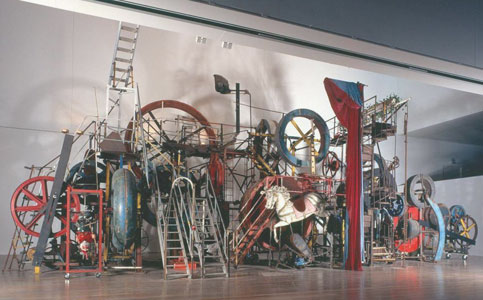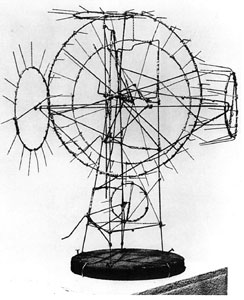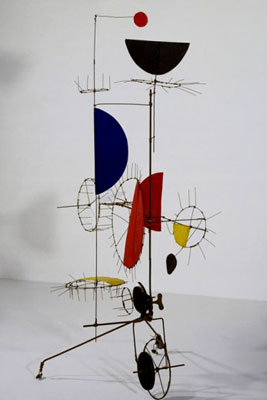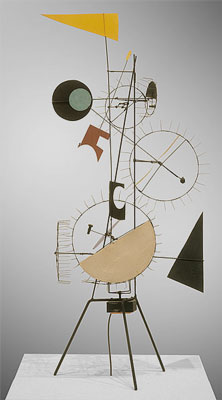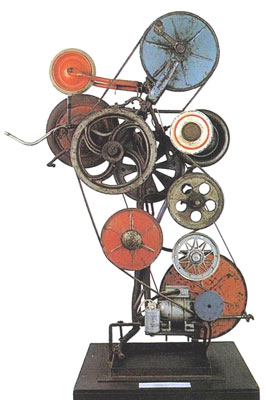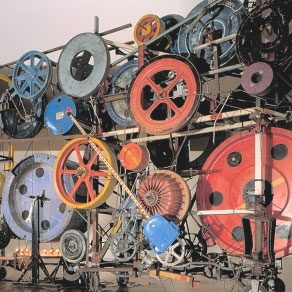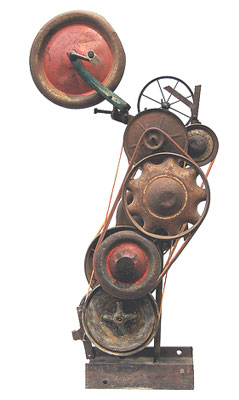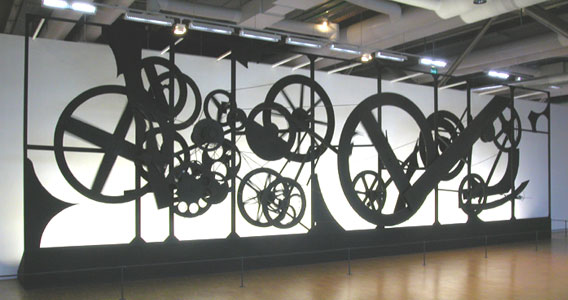|
|
Mechanical Chance
Jean Tinguely's earliest kinetic works were usually
based on painterly examples. (Méta-Malevitch,
Méta-Kandinsky, Méta-Herbin). The elements of these "kinetic
paintings" are simultaneously rotated with different speeds;
this creates an infinite variety of possible configurations.
Tinguely's next step is the construction of machines which are no longer concerned
with painting, but with movement per se. These "moving sculptures" consist
of motors, wheels, belts, cogs, and crank-shafts. Their movements are irregular
because of the machine's imperfections. This irregularity has nothing in common
with the unpredictability of Calder's mobiles à main: it is not
organic but anti-mechanic: jerking, jamming, jittering epicycles of periodic
rotations and translations. [slippen, haperen, stokken] (Rubato:
Gustav Leonhart, Thelonious Monk.)
"Tinguely discovered an
almost inexhaustible source — a mechanism whose goal was
not precision but anti-precision, the mechanics of chance." [Pontus
Hultén 1975, p. 8.]
"In machines intended for practical use the engineer tries to reduce the
irregularities as much as possible. Tinguely is after the exact opposite. His
objective is mechanical disorder. His cog-wheels are so constructed that they
jump the cogs continually, jam, and start turning again, unpredictably. (. .
.) The same movement can appear ten times in succession and then, apparently,
never be repeated again. This creates an unusually acute sense of time." [Hultén
1955, p. 26.]
"Le mot "asynchrone",
dit Tinguely, tu peux l'écrire mais en petit. C'était
plutôt un défaut mais j'ai découvert que
la création était là, la combinaison infinie:
ce n'était plus calculable." [Conil Lacoste 1989,
p. 33.]
In the "Schéma des Dispositifs", Tinguely
gives an inventory of his techniques. The construction of chance
by means of imperfections is a recurring theme in this text.
Les Courroies en cuir [le peaux
des les les Vaches - Veaux tire coupé en ficelles
au kilomètre ...... ] Glisse bien = distributeur du HASARd
(...) Les Courroies Trapezoidales Glisse aussi (...) 1953 le "META" est
LA mais "le Jolie" Meta-MECANIQUE c'est l'ENGENAGE "Libre" & hésitant – en
fil de fer tousjour "en panne" permanent Stabilité du
Hasard. (...) la "FAbricAtioN" du HASARd & de
l'IRRéGulaRité VARiAble } le MetA d'Abord le "CHAOS" stable
[Tinguely: "Schéma des Dispositifs".
In: Conil Lacoste, 1989, pp. 27-31.]
"Tinguely (...) uses an
old-fashioned technology in his machines. He likes ordinary,
conventional motors (...). As yet, with the exception of the
components from radio-sets used in his sculptures around 1962,
he has never employed electronics or other more up-to-date techniques." [
Pontus Hultén 1975, p. 307.]
"There was nothing new in the idea of deliberately introducing chance as
an element in art. (. . .) In Tinguely's case, however, it was no longer a matter
of the role of chance in the act of creation, nor of a static display of something
that had come about by chance, but of chance in action." [Pontus
Hultén 1975, p. 8.]
"With their unrepeatable and unique movements and sequences, Tinguely's
machines exist in an enviable freedom. Their vitality, spontaneity, and lyricism
bring to us ecstatic moments of life divorced entirely from moral precept or
inhibition, from good and evil, right and wrong, beautiful or ugly. His machines
are a piece of pure existence, eternally changeable, and they do not have to
mean anything or refer to anything. But one is mistaken to believe that their
artistic message is innocent or harmless. They subvert the established order
and convey a sense of anarchy and individual liberation which would otherwise
not exist." [Hultèn 1965, pp. 13/14.]
References
Alexander Calder: "Mobiles." In:
Myfanwy Evans (ed.): The Painter's Object, Gerold
Howe, London, 1937.
Michel Conil Lacoste: Tinguely.
L'Énergétique de l'Insolence. Vol.
I. Paris: Éditions de la Différence,
1989.
Karl G. Hultén: Den Ställföreträdande
Friheten eller Om Rörelse i Konsten och Tinguelys Metamekanik. (Substitute
Freedom or On Movement in Art and Tinguely's Meta-mechanics.)
Special issue of Kasark, October 1955. (English translation
in: Pontus Hultén, 1975.)
K.G. Hultèn: "Jean Tinguely." In: Jean
Cassou, K.G. Hultèn, Sam Hunter & Nicolas Schöffer: "Two
Kinetic Sculptors: Nicolas Schöffer and Jean
Tinguely." New York: October House / Jewish Museum, 1965.
K.G.
Pontus Hultén: Tinguely.
'Méta'. London: Thames
and Hudson, 1975.
|
|
